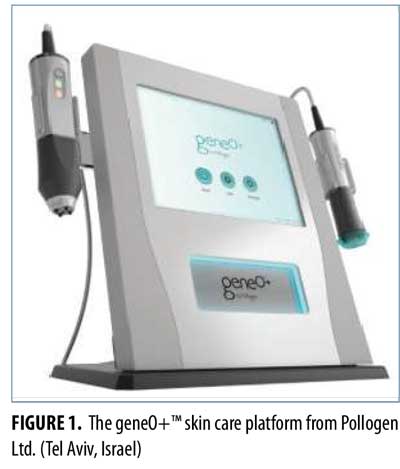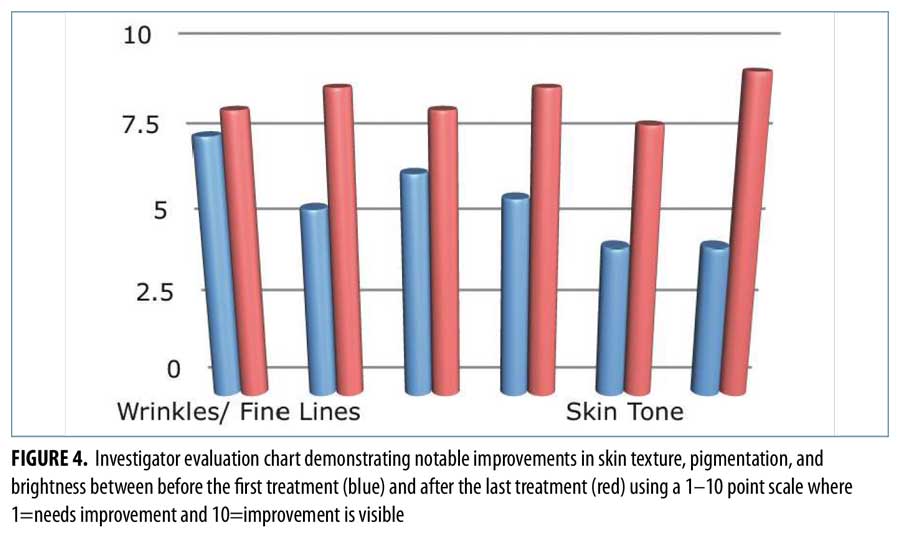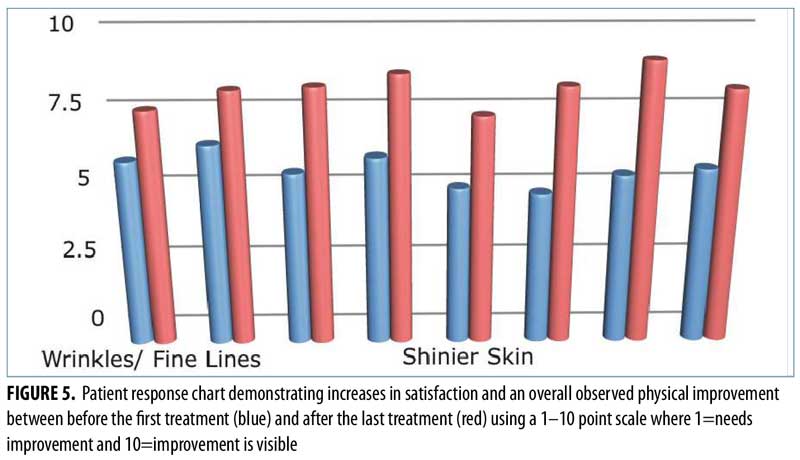by DeAnna Diaz, MS; Metavee Boonsiri, MD; Joyce Okawa, RN, MBE; Denise Dekranes, RN; and Chérie M. Ditre, MD
Dr. Ditre is the Director of the Skin Enhancement Center and Associate Professor of Dermatology at the University of Pennsylvania School of Medicine and practices at Penn Medicine in Radnor, Pennsylvania. Dr. Diaz is a first year medical student at Touro School of Osteopathic Medicine in New York, New York. Dr. Boonsiri is with the Faculty of Medicine Vajira Hospital at Navamindradhiraj University in Bangkok, Thailand. Ms. Okawa is with the University of Pennsylvania Perelman School of Medicine. Ms. Dekranes is with the University of Pennsylvania Perelman School of Medicine and Penn Medicine at Radnor.
Funding: No funding was received.
Disclosures: The authors have no conflicts of interest relevant to the content of this article.
Abstract: Background. Oxygenation of the skin has been shown to improve cell growth and cell biosynthesis, which can subsequently improve the skin’s appearance.1,2 However, the majority of skin oxygenation techniques are invasive.3,4 A noninvasive skin oxygenation treatment, also known as a carboxytherapy facial, with TriPollar® radiofrequency device has emerged called OxyGeneo™, which is provided by the geneO+™ skin care platform (Pollogen Ltd., Tel Aviv, Israel).
Objective. This study addresses the clinical effectiveness of the aforementioned noninvasive skin oxygenation treatment on skin texture, fine lines/wrinkles, and skin pigmentation over an eight-week time period.
Methods and Materials. Ten patients with fine lines, wrinkles, hyperpigmentation, and rough skin texture received six weekly treatments over a two-month period. Five patients received NeoRevive™ and five received NeoBright™ topical infusions, with the selection made according to each individual’s skin conditions and type. These patients were evaluated using the VISIA complexion analysis system (Canfield Scientific, Inc., Parsippany, New Jersey) and patient and evaluator assessments and satisfaction surveys. Photo consent was obtained and are on patient records. The OxyGeneo™ treatment equipment was commercially available at the time of the study and did not require IRB approval for cosmetic use.
Results. Each individual measurement varied by patient, but the change in value of each category that was assessed prior to treatment and post-treatment indicated an improvement. All patients in the study stated an improvement in overall skin appearance, skin texture, brightness, and shininess. Nine out of the 10 patients reported that their skin was softer and had a more youthful appearance after the treatments, and seven out of the 10 patients saw a minor improvement in fine lines and wrinkles. Lastly, five out of the 10 patients noticed an improvement in skin pigmentation.
Conclusion. The results indicated the combination of the three-in-one OxyGeneo treatment of exfoliation, infusion and oxygenation using TriPolar radiofrequency prompted an improvement in skin texture and tone. This is an optimal procedure that can be implemented in patients looking for noninvasive, safe, and effective rejuvenation treatments with no associated downtime post-procedure.
Keywords: TriPollar radiofrequency, geneO+, NeoRevive and NeoBright, OxyGeneo
J Clin Aesthet Dermatol. 2017;10(11):22–25
Introduction
During the aging process in the skin, there is a general atrophy of the extracellular matrix and a decrease in the number of fibroblasts and levels of collagen and elastin. Research has shown that increasing optimal oxygen delivery to the skin improves cell growth and cell biosynthesis.1,2 Studies have also suggested that increased oxygenation stimulates fibroblast proliferation and keratinocyte differentiation.6 This has stimulated a growing interest in oxygen-based skin treatments. However, the stability of oxygen-based compounds in topical formulations has been questioned, as has their ability to penetrate the stratum corneum effectively.
The OxyGeneo™ treatment (OGT, Pollogen Ltd., Tel Aviv, Israel) provided by the geneO+™ skin care platform (Pollogen Ltd., Tel Aviv, Israel) is a novel, noninvasive treatment that invokes skin oxygenation in combination with mechanical exfoliation and skin infusion.7 The treatment includes the performance of a light exfoliation with a simultaneous infusion of active ingredients via two treatment gels, NeoRevive™ (NR) for drier skin and skin rejuvenation and NeoBright™ (NB) for oiler skin and skin brightening, respectively. The exfoliation is preceded by TriPollar® radiofrequency (RF) technology8 (Pollogen Ltd., Tel Aviv, Israel) for noninvasive dermal remodeling, and is finished with the exchange of the exfoliation head for a massager head to provide the skin with a more vibrant, glowing appearance.
The use of carbon dioxide (CO2) through the Bohr effect has been used in subcutaneous CO2 injections in order to ensure oxygen delivery to the skin tissues.3 However, transcutaneous CO2 injections are invasive, have many side effects, and can be impractical to apply to the entire face.3,4 There is a need for noninvasive CO2 treatments that can enhance neocollagenesis with minimal pain or downtime for the patient. OGT is a noninvasive CO2 treatment that utilizes the Bohr effect. The Bohr effect is represented by an incrementation in the partial pressure of CO2 or decrease in pH as seen as a rightward shift of the O2–hemoglobin dissociation curve. CO2 incites local cutaneous vasodilation and thereby increases incremental regional blood flow, which in turn increases the oxygen availability in the skin.9 Transcutaneous CO2 delivery has been well-documented and studied. CO2 is water-soluble, making it an ideal gas for transcutaneous delivery.10
The light mechanical exfoliation provided by OGT uses a widely employed microdermabrasion system that increases skin permeability to enhance the infusion of active ingredients.11 This technology also increases circulation and oxygenation in the treated areas, enhancing the delivery and absorption of the active ingredients.12 In addition, OGT uses the RF technology to heat the dermal layer through electromagnetic energy. This, combined with the exfoliation, induces the activation of fibroblasts for the production of new collagen fibers. The result is skin tightening and an improvement of wrinkles over time.13
The purpose of our study was to determine if the OGT could improve skin texture in a short period of time. We treated 10 patients with six weekly treatments over a two-month period. Five patients received NR and five received NB topical infusions according to their individual skin conditions and type. These patients were evaluated using the VISIA complexion analysis system (Canfield Scientific, Inc., Parsippany, New Jersey) and patient and evaluator assessments and satisfaction surveys.
Methods
This was a single-center study that involved 10 healthy female patients 27 to 61 years of age. Study protocol followed the ethical principles of the Helsinki Declarion. Patients gave informed consent to undergo six weekly OGTs with the geneO+ platform device (Figure 1). Patients also gave photoconsent. The inclusion criteria were healthy female patients of any racial/ethnic origin with Fitzpatrick skin types I to VI who were aged between 25 years and 65 years. Exclusion criteria were a current presence or history of skin cancer; pregnancy; lactation; active dermatologic conditions in the treatment area; vascular disorders in the treatment area; recent use of resurfacing products or treatments on the treatment area; known allergies to cosmetics or other products; and/or the performance of any recent surgical, ablative, or invasive procedure including fillers or botulinum toxin.

Treatments were performed using the OGT technology (Figure 1) that uses the patented Capsugen™ capsule (Pollogen Ltd., Tel Aviv, Israel) in combination with the NR or NB treatment gels. The disposable capsule is attached to handheld applicator that vibrates the treatment area with the treatment gel, which together creates a CO2-rich reaction. This reaction produces a layer of CO2 microbubbles that exfoliate and optimally penetrate the skin, which drives oxygen-rich blood to the skin to increase its oxygenation and permeability for the infused treatment gels. Treatments in this study were performed using two types of treatment gels: NR, for those subjects with drier skin and skin rejuvenation, and NB, for those subjects with oiler skin and skin brightening. The patients were assigned the gel that best matched their condition and skin type. This was followed by an RF add-on applicator of the geneO+ platform (Figure 1) that uses well-established electromagnetic energy to generate heat to stimulate dermal remodeling. The RF applicator has three preset power levels for the desired pre-programmed threshold temperature and intensity. In addition, there is a safety mechanism to turn off the RF power when the maximal threshold is detected, in order to prevent epidermal overheating. This applicator is treated with a thin layer of treatment gel and moved in slow circular motions, having full contact of the skin in the treatment area. Lastly, the exfoliation capsule is exchanged with a massager head that is applied to the treatment area with the remaining thin layer of treatment gel in a circular uniform motion.
Patients were photographed at baseline, after the first treatment, before the second and fourth treatments, and after the sixth treatment using the VISIA analysis system. This device grades skin texture and hyperpigmentation based on a numerical analysis via ultraviolet, cross-polarization, and standard photography. Five patients were asked to complete a self-evaluation questionnaire scaled from 1 (signifying needs improvement) to 10 (signifying an improvement is visible in regards to various variables such as wrinkles/fine lines, skin pigmentation, skin texture, skin brightness and overall skin appearance) after the first, second, fourth, and final treatments.
Results
Each individual measurement varied by patient, but the change in value of each category that was assessed prior to treatment and post-treatment demonstrated an improvement. Although fine lines/wrinkles only demonstrated minor improvement, presumably due to the short time course of treatment (i.e., only six weeks), skin texture, pigmentation and brightness all substantially improved, as demonstrated by the investigator evaluation chart in Figure 4. Reports of patient satisfaction collected from all 10 of the patients stated there was a marked improvement in overall skin appearance, skin texture, brightness, and shininess. Nine out of the 10 patients reported softer and more youthful appearing skin after the treatments, and seven out of the 10 patients saw minor improvements in fine lines and wrinkles. Lastly, five out of the 10 patients noticed an improvement in skin pigmentation, as seen in Figures 2 and 3, that demonstrates an improvement in post-inflammatory hyperpigmentation on the left cheek. Overall, all of the patients showed a trend of increased satisfaction and overall improvement from the first to last treatment (Figure 5). All of the 10 patients stated they would recommend this product, and eight out of the 10 stated they would continue with the treatment. Cost of the treatment was reported as the reason that the other two participants did not wish to continue the treatment. All 10 patients vocalized that the overall treatment procedure had minimal to no pain, adding specifically that the first exfoliating portion was slightly abrasive with mild tingling, but tolerable.




Discussion
The therapeutic and medical use of CO2 was first introduced in France for cutaneous use in the early 1900s, specifically for the treatment of peripheral vascular disease.14 CO2 treatment is known as carboxytherapy and refers to the cutaneous and subcutaneous administration of CO2 for therapeutic purposes. In South America and Europe, CO2 therapy has not only been used therapeutically, but has been applied aesthetically for the treatment of stretch marks, cellulite, and hypertrophic scars, with impressive results.10,15 When first introduced, treatment was delivered by bathing the skin in CO2-enriched water or natural CO2 spa gas.10,16,17 CO2 injections were later introduced in plastic surgery for skin irregularities or adiposities.15 Studies have demonstrated that carboxytherapy improves skin elasticity and circulation, encourages collagen repair, reduces the appearance of fine lines and wrinkles, and destroys localized fatty deposits by increasing blood flow, microcirculation, and oxygenation in ischemic tissues as explained by the Bohr effect.10 However, CO2 injections are invasive and have many side effects, including pain, bruising, swelling, and a tendency for infection.4 Therefore, a noninvasive carboxytherapy is optimal. The novel OGT is a ideal option due to its noninvasive nature. Through the Bohr effect, CO2 diffuses into the capillary blood and into the red blood cells. Inside the red blood cells, CO2 and water generate carbonic acid that dissociates into protons and bicarbonate ions. These protons induce a conformational change reducing the hemoglobin affinity for oxygen, increasing the tissue oxygen content in the treatment area.18 The capsules of the OGT handheld applicator are composed of sodium bicarbonate and citric acid. This combination interacts with the treatment gel and releases CO2 as demonstrated in the following formula:
3NaHCO?+C6H8O7—>Na3C6H5O7+3CO2+3H2O, where NaHCO3 is sodium bicarbonate, C6H8O7 is citric acid, the arrow represents the interaction with the specialized gel, Na3C6H5O7 is sodium citrate, CO2 is carbon dioxide, and H2O is water.
The high carbonate content released into the tissues induces a release of oxygen from the red blood cells’ hemoglobin. In addition, the vibration of the handheld applicator induces an exfoliation, increasing the skin’s permeability for better infusion of the treatment gels. The RF application then induces neocollagenesis and dermal repair.8
Conclusion
The purpose of this study was to assess the aesthetic improvements induced by OGT, a noninvasive carboxytherapy treatment. The data demonstrated that OGT prompts an improvement in overall skin appearance, texture, and feel. Patients were satisfied with the impact on their skin texture, brightness, and overall appearance, although there was no drastic improvement of fine line and wrinkles. The results of this study demonstrate the effectiveness of the OGT on skin texture and tone and its feasibility as a noninvasive skin treatment with minimal pain and no downtime. The combination of the three-in-one OGT of exfoliation, infusion, and oxygenation and the use of the RF technology makes it an optimal procedure for skin rejuvenation that can be implemented in patients looking for a noninvasive, safe, and effective treatment that will give the desired aesthetic improvement in skin tone and texture within a short period of time (two months) without downtime post-procedure.19–24
References
- Mehm WJ, Pimsler M, Becker RL, Lissner CR. Effect of oxygen on in vitro fibroblast cell proliferation and collagen biosynthesis. Undersea Hyperb Med. 1988;3(4)227–234.
- Callaghan TM, Wilhelm KP. A review of ageing and an examination of clinical methods in the assessment of ageing skin. part I: cellular and molecular perspectives of skin ageing. Int J Cosmetic Sci. 2008;30(5):313–322.
- Brandi C, D;Aniello C, Grimaldi L, et al. Carbon dioxide therapy in the treatment of localized adiposities: Clinical study and histopathological correlations. Aesthetic Plast Surg. 2001;25(3):170–174.
- Paolo F, Nefer F, Paola P, Nicolo S. Periorbital area rejuvenation using carbon dioxide therapy. J Cosmet Dermatol. 2012;11(3):223–228.
- Demirli R, Otto P, Viswanathan R, et al. RBX™ technology overview. Available at: http://www.canfieldsci.com/FileLibrary/RBX%20tech%20overview-LoRz1.pdf . Accessed April 5, 2016.
- Dimitrijevich SD, Paranjape S, Wilson JR, et al. Effect of hyperbaric oxygen on human skin cells in culture and in human dermal and skin equivalents. Wound Repair Regen. 1999;7(1): 53–64.
- Seidel R, Moy R. Effect of carbon dioxide facial therapy on skin oxygenation. J Drugs Dermatol. 2015;14(9):976–980.
- Sadick NS, Malerich SA, Nassar AH, Dorizas AS. Radiofrequency: An update on latest innovations. J Drugs Dermatol. 2014;13(11):1331–1335.
- Ferreira LM, Silva EKd, Jaimovich CA, et al. Carboxiterapia: Buscando evidência para aplicação em cirurgia plástica e dermatologia. Rev Bras Cir Plást. 2012;27(3):350–351.
- Rojas M, Sakai Y, Miwa M, et al. A novel system for transcutaneous application of carbon dioxide causing an “artificial Bohr effect” in the human body. PLoS ONE. 2011;6(9):e24137.
- Gill HS, Andrews SN, Sakthivel SK, et al. Selective removal of stratum corneum by microdermabrasion to increase skin permeability. Eur J Pharm Sci. 2009;38(2):95–103.
- Levenberg A. Clinical experience with a TriPollar radiofrequency system for facial and body aesthetic treatments. Eur J Dermatol. 2010;20(5):615–619.
- Shapiro SD, Eros Y, Abrahami Y, Leviav A. Evaluation of safety and efficacy of the TriPollar technology for treatment of wrinkles. Lasers Surg Med. 2012;44(6):453–458.
- Brockow T, Hausner T, Dillner A, Resch K. Clinical evidence of subcutaneous CO2 insufflations: a systematic review. J Altern Complement Med. 2000;6(5):391–403.
- Brandi C, D’Aniello C, Grimaldi L, et al. Carbon dioxide therapy in the treatment of localized adiposities: clinical study and histopathological correlations. Aesthetic Plast Surg. 2001;25(3):
170–174. - Varlaro V, Manzo G, Mugnaini F, et al. Carboxytherapy: effects on microcirculation and its use in the treatment of severe lymphedema. Acta Phlebol. 2007;8(2):79–91.
- Hartmann BR, Bassenge E, Hartmann M. Effects of serial percutaneous application of carbon dioxide in intermittent claudication: results of a controlled trial. 1997;48(11):957–963.
- Jensen FB. Red blood cell pH, the Bohr effect, and other oxygenation-linked phenomena in blood O2 and CO2 transport. Acta Physiol Scand. 2004;182(3):215–227.
- Azocar J. A novel technique for increasing skin oxygenation. Adv Skin Wound Care. 2014;27(7):324–327.
- Levenberg A, Shpolansky U. geneO+ A Novel Skin Care Platform For Anti Aging And Rejuvenation Based On Unique OxyGeneo And TriPollar RF Technologies. Available at: http://www.pollogen.com/images/clinical/doc/whitepaper/geneO%20A%20Novel%20Skin%20Care%20Platform%20for%20anti-aging%20and%20rejuvenation%20based%20on%20Oxygeneo%20and%20TriPollar%20Technologies.pdf. Accessed April 5, 2016.
- Balik O, Yilmaz M, Bagriyanik A. Does carbon dioxide therapy really diminish localized adiposities? experimental study with rats. Aesthetic Plast Surg. 2011;35(4):470–474.
- Prendergast PM, Shiffman MA. Aesthetic Medicine: Arts and Techniques. New York, NY: Springer; 2012.
- West MD. The cellular and molecular biology of skin aging. Arch Dermatol. 1994;130(1):87–95.
- Winter G, Perrins D. Effects of hyperbaric oxygen treatment on epidermal regeneration. In: Wada J, Iwa T, eds. Proceedings of the Fourth International Congress on Hyperbaric Medicine. Baillere, London; 1970: 363–368.

